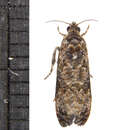Conservation Status
provided by University of Alberta Museums
Not of concern.
- license
- cc-by-nc
- copyright
- University of Alberta Museums
Cyclicity
provided by University of Alberta Museums
Emergence of adult moths has been recorded between late April and mid June (Hilton 1982). Alberta specimens have been collected from early July to early September.
- license
- cc-by-nc
- copyright
- University of Alberta Museums
Distribution
provided by University of Alberta Museums
Widespread distribution in North America. In the United States of America this species has been found in the states of Massachusetts, New York, New Jersey, Pennsylvania, Maryland, Virginia, North Carolina, Florida, Texas, Ohio, Indiana, Missouri and California. In Canada this species has been found in the provinces of British Columbia, Alberta, Manitoba and Ontario (Heinrich 1926). Alberta specimens have been collected in Edmonton and Nordegg. Miller (1983) indicates that this species has been reported in the Palaearctic Region.
- license
- cc-by-nc
- copyright
- University of Alberta Museums
General Description
provided by University of Alberta Museums
A medium sized Endothenia, the forewing for both males and females generally ranges between 5.0-8.2 mm in length (Heinrich 1926). Color of the forewings ranges from dusky brown to clay and coloration pattern tends to be uniform (Sabourin and Landry 2000). Mottled colors on the forewings can be present, however there is little contrast with the other wing colors. Heinrich (1926) suggests that the median and basal dark area of the forewing can be mottled with deep black scales but Alberta specimens of Endothenia montanana also show this character. An important character that can be used to help distinguish this species from similar species is the presence of yellow hair penciles on the hind tibia of males with no darker hairs present (Heinrich 1926 and Sabourin and Landry 2000).
- license
- cc-by-nc
- copyright
- University of Alberta Museums
Habitat
provided by University of Alberta Museums
Black spruce-sphagnum bogs (Hilton 1982).
- license
- cc-by-nc
- copyright
- University of Alberta Museums
Life Cycle
provided by University of Alberta Museums
Univoltine or multivoltine depending on latitude (Hilton 1982). This species has five instars with instars 4 and 5 over wintering in the flower stalks of their host plant (Hilton 1982 and Miller 1983). Pupation occurs in late May and adults emerge from pre-chewed holes in flower stalks. There are two main ichneumonid parasites of Endothenia hebesana larvae; Scambus spp. and Glypta sp., and both are known to be parasitoids. (Hilton 1982)
- license
- cc-by-nc
- copyright
- University of Alberta Museums
Trophic Strategy
provided by University of Alberta Museums
Larvae feed mostly on developing host seeds. Reported host plant genera include: Antirrhinum, Gentiana, Gerardia, Iris, Orthocarpus, Penstemon, Physostegia, Solidago, Stachys, Teucrium, Tigridia, Verbascum, Verbena, Veronica, Sarracenia, Scrophularia and Scutellaria (Heinrich 1926 and Miller 1983).
- license
- cc-by-nc
- copyright
- University of Alberta Museums
Endothenia hebesana
provided by wikipedia EN
Endothenia hebesana, the verbena bud moth, is a species of moth of the family Tortricidae. It is found in North America, where it has been recorded from Massachusetts, New York, New Jersey, Pennsylvania, Maryland, Virginia, North Carolina, Florida, Texas, Ohio, Indiana, Missouri, California, British Columbia, Alberta, Manitoba and Ontario.[2] The habitat consists of black spruce-sphagnum bogs.
The length of the forewings is 5-8.2 mm for both sexes. The forewings vary from dusky brown to clay. Adults are on wing from late April to mid-June in one or multiple generations per year depending on the latitude.
The larvae feed on the seeds of Antirrhinum, Gentiana, Gerardia, Iris, Orthocarpus, Penstemon, Physostegia, Solidago, Stachys, Teucrium, Tigridia, Verbascum, Verbena, Veronica, Sarracenia, Scrophularia and Scutellaria species. There are five larval instars. Instars four and five overwinter in the flower stalks of the host plant. Pupation takes place in late May.[3]
References

- license
- cc-by-sa-3.0
- copyright
- Wikipedia authors and editors
Endothenia hebesana: Brief Summary
provided by wikipedia EN
Endothenia hebesana, the verbena bud moth, is a species of moth of the family Tortricidae. It is found in North America, where it has been recorded from Massachusetts, New York, New Jersey, Pennsylvania, Maryland, Virginia, North Carolina, Florida, Texas, Ohio, Indiana, Missouri, California, British Columbia, Alberta, Manitoba and Ontario. The habitat consists of black spruce-sphagnum bogs.
The length of the forewings is 5-8.2 mm for both sexes. The forewings vary from dusky brown to clay. Adults are on wing from late April to mid-June in one or multiple generations per year depending on the latitude.
The larvae feed on the seeds of Antirrhinum, Gentiana, Gerardia, Iris, Orthocarpus, Penstemon, Physostegia, Solidago, Stachys, Teucrium, Tigridia, Verbascum, Verbena, Veronica, Sarracenia, Scrophularia and Scutellaria species. There are five larval instars. Instars four and five overwinter in the flower stalks of the host plant. Pupation takes place in late May.
- license
- cc-by-sa-3.0
- copyright
- Wikipedia authors and editors

